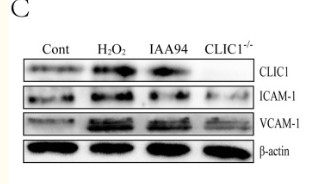ICAM-1 Polyclonal Antibody
- Catalog No.:YT2269
- Applications:WB;IHC;IF;ELISA
- Reactivity:Human;Rat;Mouse;
- Target:
- ICAM-1
- Fields:
- >>NF-kappa B signaling pathway;>>Cell adhesion molecules;>>Natural killer cell mediated cytotoxicity;>>TNF signaling pathway;>>Leukocyte transendothelial migration;>>AGE-RAGE signaling pathway in diabetic complications;>>African trypanosomiasis;>>Malaria;>>Staphylococcus aureus infection;>>Influenza A;>>Human T-cell leukemia virus 1 infection;>>Kaposi sarcoma-associated herpesvirus infection;>>Epstein-Barr virus infection;>>Rheumatoid arthritis;>>Viral myocarditis;>>Lipid and atherosclerosis;>>Fluid shear stress and atherosclerosis
- Gene Name:
- ICAM1
- Protein Name:
- Intercellular adhesion molecule 1
- Human Gene Id:
- 3383
- Human Swiss Prot No:
- P05362
- Mouse Swiss Prot No:
- P13597
- Immunogen:
- The antiserum was produced against synthesized peptide derived from human ICAM-1. AA range:479-528
- Specificity:
- ICAM-1 Polyclonal Antibody detects endogenous levels of ICAM-1 protein.
- Formulation:
- Liquid in PBS containing 50% glycerol, 0.5% BSA and 0.02% sodium azide.
- Source:
- Polyclonal, Rabbit,IgG
- Dilution:
- WB 1:500 - 1:2000. ELISA: 1:10000.. IF 1:50-200
- Purification:
- The antibody was affinity-purified from rabbit antiserum by affinity-chromatography using epitope-specific immunogen.
- Concentration:
- 1 mg/ml
- Storage Stability:
- -15°C to -25°C/1 year(Do not lower than -25°C)
- Other Name:
- ICAM1;Intercellular adhesion molecule 1;ICAM-1;Major group rhinovirus receptor;CD antigen CD54
- Observed Band(KD):
- 58kD
- Background:
- This gene encodes a cell surface glycoprotein which is typically expressed on endothelial cells and cells of the immune system. It binds to integrins of type CD11a / CD18, or CD11b / CD18 and is also exploited by Rhinovirus as a receptor. [provided by RefSeq, Jul 2008],
- Function:
- function:ICAM proteins are ligands for the leukocyte adhesion protein LFA-1 (integrin alpha-L/beta-2). During leukocyte trans-endothelial migration, ICAM1 engagement promotes the assembly of endothelial apical cups through SGEF and RHOG activation. In case of rhinovirus infection acts as a cellular receptor for the virus.,online information:ICAM-1,online information:Icosahedral capsid structure,online information:Intercellular adhesion molecule entry,polymorphism:Homozygotes with ICAM1-Kalifi Met-56 seem to have an increased risk for cerebral malaria.,PTM:Monoubiquitinated, which is promoted by MARCH9 and leads to endocytosis.,similarity:Belongs to the immunoglobulin superfamily. ICAM family.,similarity:Contains 5 Ig-like C2-type (immunoglobulin-like) domains.,subunit:Homodimer (Probable). Interacts with human herpesvirus 8 MIR2 protein (Probable). Interacts with MUC1 and promotes cell a
- Subcellular Location:
- Membrane; Single-pass type I membrane protein.
- Expression:
- Blood,Kidney,Liver,Melanoma,Plasma,
CLIC1 Inhibition Attenuates Vascular Inflammation, Oxidative Stress, and Endothelial Injury. PLoS One Plos One. 2016 Nov;11(11):e0166790 WB Human,Mouse aortas HUVECs
Tanshinone IIA Sodium sulfonate regulates antioxidant system, inflammation, and endothelial dysfunction in atherosclerosis by downregulation of CLIC1. EUROPEAN JOURNAL OF PHARMACOLOGY Eur J Pharmacol. 2017 Nov;815:427 WB Human,Mouse aortas HUVECs
- June 19-2018
- WESTERN IMMUNOBLOTTING PROTOCOL
- June 19-2018
- IMMUNOHISTOCHEMISTRY-PARAFFIN PROTOCOL
- June 19-2018
- IMMUNOFLUORESCENCE PROTOCOL
- September 08-2020
- FLOW-CYTOMEYRT-PROTOCOL
- May 20-2022
- Cell-Based ELISA│解您多样本WB检测之困扰
- July 13-2018
- CELL-BASED-ELISA-PROTOCOL-FOR-ACETYL-PROTEIN
- July 13-2018
- CELL-BASED-ELISA-PROTOCOL-FOR-PHOSPHO-PROTEIN
- July 13-2018
- Antibody-FAQs
- Products Images

- Xu, Yingling, et al. "CLIC1 inhibition attenuates vascular inflammation, oxidative stress, and endothelial injury." PloS one 11.11 (2016): e0166790.

- Western Blot analysis of various cells using ICAM-1 Polyclonal Antibody diluted at 1:500
.jpg)
- Western Blot analysis of HepG2 cells using ICAM-1 Polyclonal Antibody diluted at 1:500



